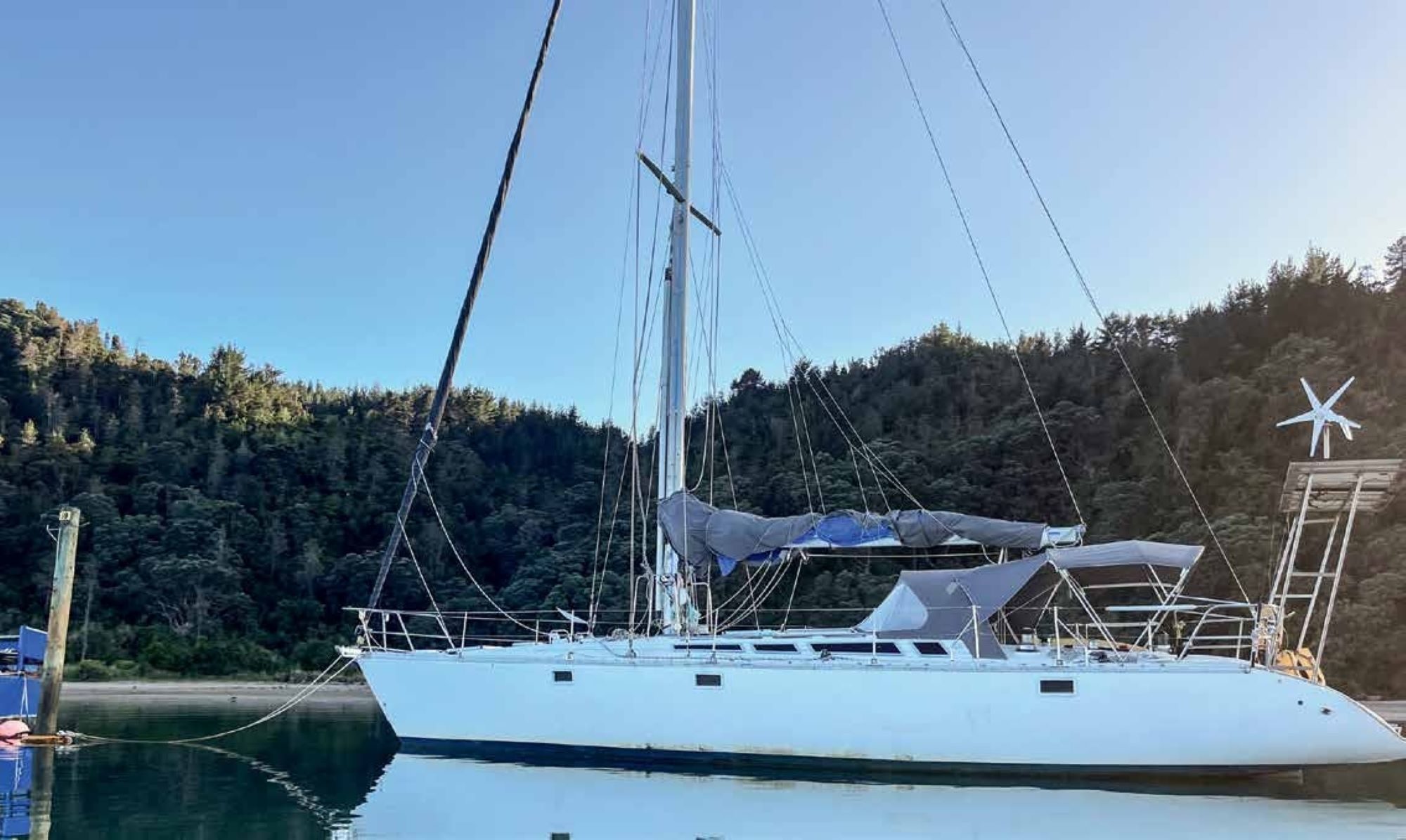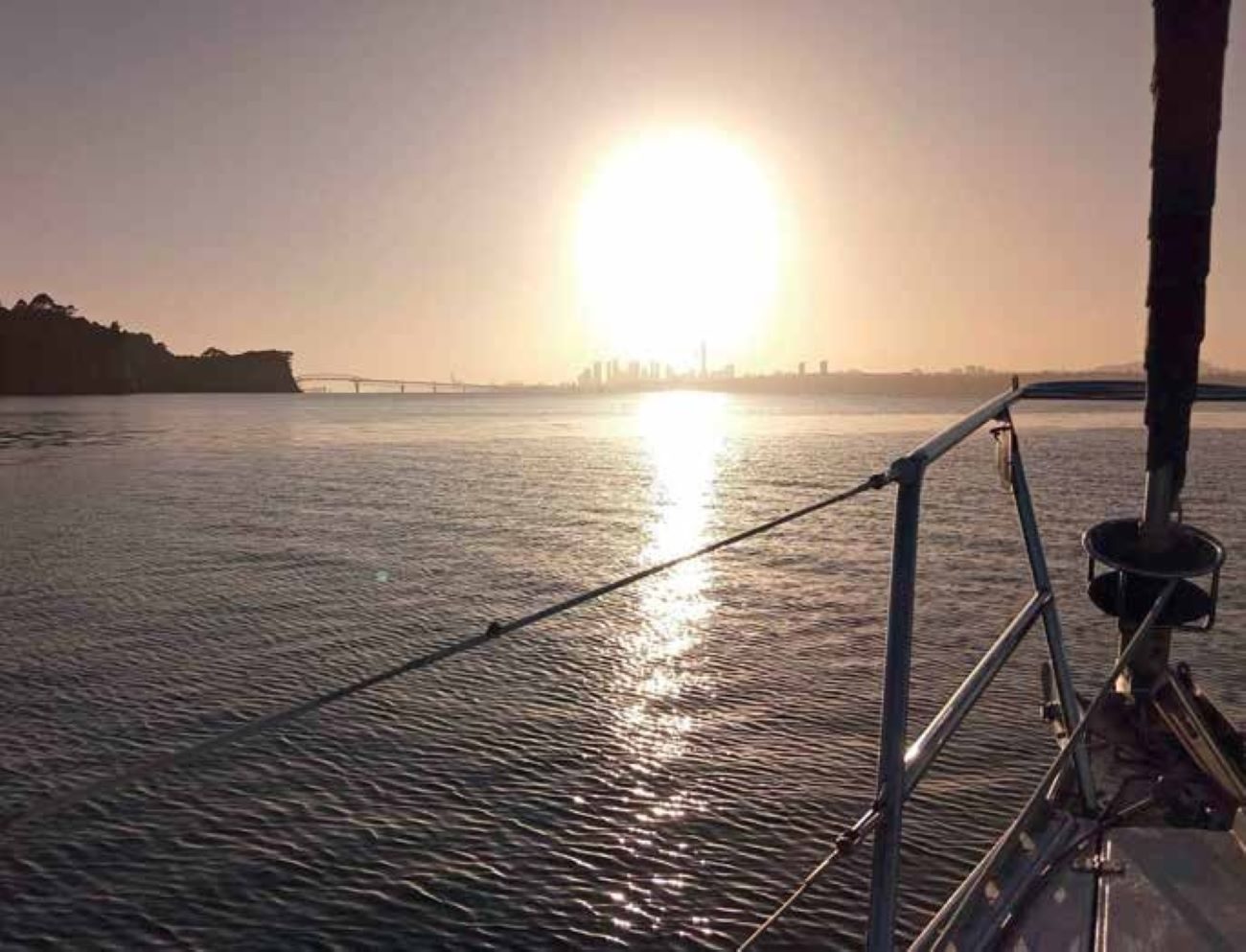

This column marks the second sail of our 2022 spring-summer season, which we undertook in September. It was not without its challenges!
As you may recall, our first journey involved sailing across to beautiful Woody Bay at Rakino Island. This time, with the advent of the September school holidays, we headed over to Waiheke Island and enjoyed a week away at Man O’ War Bay.
We had a reasonably uneventful sail – the weather was sunny with a little (enough) wind. To sail as much as possible, we travelled the slow, circuitous route from Gulf Harbour Marina down past Takapuna and Devonport, just touching the entry to the Waitemata Harbour and around the bottom of Rangitoto Island and then Motuihe Island, and finally, Waiheke Island.
During our sail, we ran a new fishing lure and amazingly (as we generally have limited success) we caught a good-sized kahawai! Then the challenge began: to end up with an edible fish, we first had to bleed it.


Let’s just say I am used to catching snapper and the concept of bleeding a fish is new. I put into practice the technique my brother-in-law taught me. The theory was great, but the practice was very bloody with blood finding its way all over the cockpit!
To my relief, my wife didn’t freak, she simply kept steering. We grabbed the hose and cleaned down the cockpit. It was certainly a mess! Lesson learned for next time: bleed into a bucket.
We arrived at Man O’ War in reasonably peaceful weather but knowing 36 hours of very strong winds would follow. And yes, the weather forecast lived up to its promise. Sauvage was buffeted in the strong wind, frequently changing angles and swinging around the anchor, but we were happy with our holding. We stayed onboard and simply enjoyed the chill time!
A day and a bit after we arrived, the wind died down and we went ashore.
Now, this is not our first visit Man O’ War Bay, so once on shore we knew to head straight to the amazing Man O’ War Vineyards Restaurant which serves great food and wine in a relaxed environment, and did I mention, good wine? We spent a few hours having a grand old time at the restaurant, and then exploring the shoreline afterwards. We were on holiday and enjoying it.


On the less pleasing side – and very much as you might expect on the first long-ish sail of a new season – we experienced some technical issues with the boat. While pulling up the anchor, the windlass ‘died’. As I was chasing the anchor from the cockpit the windlass motor stopped pulling the anchor. We caught on a rock which added a bit of stress to the lift; but once the rock issue was resolved, the windlass remained unresponsive.
After a quick-glance investigation found nothing out of the ordinary, I retrieved the anchor by hand (a far easier job that I had expected), and we got underway to Hooks Bay, spending the night there before, yes, manually putting the anchor out and then, in the morning, pulling it up again by hand.
Later, back at the marina, a bit more investigation into the windlass issue found nothing obviously wrong, but that in itself is something to be concerned about! It is incredibly hard to fix something when you can’t find the actual cause of the problem.
I did find an oil top-up/dipstick, which I hadn’t been aware of previously –one which we will check more regularly from now on.

In the sail locker, I located two forward/reverse solenoids, very rusty having had a long and salty life, and the remote controller (the up/down controller attached by a three-core wire to the solenoids), also old and a bit temperamental, as you must push the buttons in just the right way for it to work. But, despite their age and quirks, the solenoids and the remote controller all proved functional.
At that point in our investigation, we resolved to remove the windlass and bring it home. The following week I took it to my parents’ house – my dad is a motor-mechanic, and his skills are highly appreciated at times like this. Together, Dad and I removed the 12V motor which runs the gears and with further exploration discovered that the motor ran fine on its own. The moving the parts we could access in the gears also moved freely and I could make the lifting drum move by manually manipulating its cogs.
At this point I was a little stumped. Stumped, but not beaten. I removed the motor and took it to our local auto electrician, who spent 30 minutes doing a full check before declaring that the windlass motor was indeed in top notch condition! What?
Surely, it had to be broken? Why else wouldn’t my anchor lift?

Chris Jnr and I reassembled the windlass. Boating is great like this – I really love how we regularly get some great dad and son time (and this month I have been both the dad and the son!). I returned the windlass to Sauvage, and without screwing it down (I had to test it first) wired it into position and tried it one last time. It still didn’t work!
We were able to hear the solenoid ‘click’ into the ‘on’ position, but no movement from the windlass motor. Still not beaten, I started to work through the problem backwards, by first removing the solenoids from the locker wall and looking more closely at them. The clicking Chris Jnr and I heard indicated to me that although they were fully functional, they were not working for us. So I used the almost ever-reliable internet to search for the component, finding one, but not in stock at Gulf Harbour.
Then, much to my annoyance, as I undid the second remote control wire from the solenoid, the screw attachment snapped off – it was simply rusted through. Great, something else to replace, but in saying that, the remote was not the cause of the windlass problem.
Still not beaten, I checked the integrity of the electrical cable (it’s a heavyweight cable) and this tested fine. Next, I re-checked the cable connection to the electrical block situated by the master switch on the motor battery. Again, nothing appeared out of the ordinary. By now I was beginning to feel that I was going in circles. I had checked the windlass end-to-end and nothing!

As a final, final step, I followed the cable from the master electrical block, back in front of the motor (very useful as I found an electrical cable from the wind turbine rubbing on the front of the motor – something to resolve later!) and over to a bulkhead on the starboard side of the boat. There, behind the house electrical controls, was a cupboard which housed the cable.
The moment I opened that cupboard door, the penny dropped. There in that cupboard was the fuse, and it had popped. Damn! The whole issue was the fuse!
I suppose, if nothing else, I am now a lot more familiar with the inside of the windlass and I know how it works, from the motor to the gears to the electrics to the cable and to that insufferable fuse! BNZ





